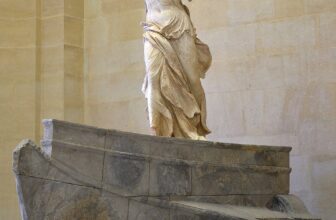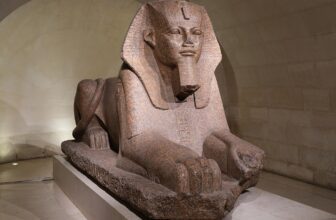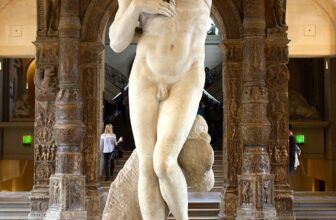
Diana of Versailles: The Journey of a Goddess from Olympus to the Titanic
Long before the cold Atlantic swallowed the RMS Titanic into its dark depths, before a marble goddess stood poised in the Louvre’s grand halls, and before archaeologists uncovered her ancient grace, there was Diana, huntress, protector, virgin goddess, immortal and untamed.
She was once worshiped under the open skies of the Roman Empire, her name whispered in the sacred groves of Aricia and etched into marble in the temples of the divine. But Diana did not remain a relic of myth. Her presence moved through history, art, and tragedy, finding herself again and again in places far removed from her celestial origins.
This is the story of Diana of Versailles, the iconic statue housed in the Louvre, and the strange, lesser-known mystery of a Diana statue on the Titanic, and what became of her when the ship met its fate.
I. The Goddess Diana: Eternal in Myth and Marble
In Roman mythology, Diana was the goddess of the hunt, the moon, wild animals, and childbirth. She was the Roman counterpart to the Greek goddess Artemis, daughter of Jupiter (Zeus in Greek mythology) and twin sister to Apollo. Diana was revered for her fierce independence, chastity, and her power to roam untamed lands with her bow and arrows.
Unlike the gods who preferred opulent temples or mountain thrones, Diana’s realm was the wilderness. She hunted under the stars, accompanied by nymphs and woodland creatures. Worshippers saw her as both a nurturing guardian and a fearsome protector. To anger Diana was to invite swift and divine retribution, as the hunter Actaeon learned when he stumbled upon her bathing and was transformed into a stag, devoured by his own hounds.
This blend of purity, wildness, and latent power captivated ancient sculptors, Renaissance artists, and Enlightenment collectors alike. And it is precisely this mystique that breathes through the Diana of Versailles, the famous sculpture that would come to symbolize her for generations.
II. Diana of Versailles: The Louvre’s Masterpiece
The Diana of Versailles is a larger-than-life Roman marble statue from the 1st or 2nd century CE, believed to be a copy of a lost Greek original attributed to Leochares, a 4th-century BCE sculptor. It shows the goddess in mid-motion, striding forward with her right arm raised, originally drawing an arrow from a now-missing quiver. A stag stands at her side, symbolizing her dominion over nature.
But where did this magnificent statue come from?
The statue was discovered in Italy, most likely at Hadrian’s Villa in Tivoli, a sprawling complex built by the Roman Emperor Hadrian in the 2nd century CE. The villa was a treasure trove of classical sculptures, many of which were later unearthed during Renaissance excavations. Diana was among them, her marble form buried for centuries beneath layers of earth and time.
From there, she found her way to France. The statue was gifted to King Henry II of France by Pope Paul IV in the 16th century. It was installed in the Château de Fontainebleau, later moved to the Palace of Versailles—hence her moniker “Diana of Versailles”, and eventually, in 1798, she was transferred to the Louvre Museum in Paris, where she remains a centerpiece of the antiquities collection.
Towering at over 2 meters (roughly 6 ft 9 inches), Diana of Versailles is more than a statue. She is the embodiment of elegance in motion, lean muscles, flowing drapery, purposeful stride, all carved with divine precision.
III. A Goddess Aboard a Tragedy: The Titanic’s Diana
While the Louvre’s Diana stood in eternal stillness, her myth traveled across seas. When the RMS Titanic embarked on her ill-fated maiden voyage in April 1912, luxury followed her to the North Atlantic. Among the opulent decor and priceless cargo was a statue of Diana, though not the Louvre original, this was a smaller, strikingly elegant representation of the huntress goddess.
Known in ship manifests and survivor accounts simply as “a statue of Diana,” this piece was part of the First-Class Smoking Room décor, placed near the grand staircase, a symbol of class, taste, and civilization’s connection to the glories of antiquity. While its precise origins are murky, it is believed the Titanic’s Diana was a bronze or plaster replica, perhaps inspired by the Versailles version or another neoclassical representation of the goddess.
She stood among mahogany walls and gilded railings, watching gentlemen in evening coats sip brandy and discuss industry and empire. The statue was meant to evoke a sense of grace, power, and timeless beauty, values that Titanic herself embodied in the eyes of her creators.
But unlike her marble sister in the Louvre, this Diana’s time was measured in days.
IV. How Big Was the Titanic’s Diana Statue?
Reports vary, but based on deck plans and descriptions from Titanic’s decorators, the statue was roughly life-sized, standing between 5 to 6 feet tall. She may have been mounted on a pedestal or placed near a fireplace as a decorative focal point.
The statue was admired for its form and detail, bow in hand, foot forward, as if she might leap into the hunt. Though no photographs of the Titanic’s Diana have surfaced (or survived), references in documents suggest she was cast in patinated bronze or white-painted plaster, fitting seamlessly with the Edwardian neoclassical aesthetic.
This was not a museum piece but a symbol, an ornament of opulence on a ship that believed itself unsinkable.
V. When the Ice Came: Diana’s Fate on April 14, 1912
When Titanic struck the iceberg on the night of April 14, 1912, all illusions shattered. The unsinkable was sinking. Panic swept the decks. Lifeboats were lowered into freezing waters. Music played through the night, muffling the sound of collapsing steel and splintering wood.
And somewhere near the first-class staircase, as water rushed inward and the great ship groaned under its own weight, Diana fell.
Whether she was ripped from her pedestal, swallowed by flooding corridors, or shattered as the ship broke apart, her fate was sealed with Titanic’s. No record states explicitly what became of her. Unlike jewels or luggage, statues were not catalogued as recoverable artifacts. When Robert Ballard discovered the wreck in 1985, no Diana was among the relics found.
Still, in the legends surrounding the ship, Diana remains a ghostly presence. Some Titanic historians even claim to have seen fragments of what could be sculpture debris near the grand staircase, though these remain unconfirmed.
One poetic theory suggests she sank with dignity, like a Roman general falling on his sword. Another imagines her shattered—violently ripped from a place of honor. Still others whisper she remains upright in the sunken wreck, preserved like a silent sentinel.
But most agree: Diana went down with the Titanic.
VI. Diana in Memory and Myth
There’s something hauntingly appropriate about Diana’s presence on the Titanic.
The goddess of the hunt, often associated with the moon, witnessed the cold moonlight that night as chaos unfolded. A protector of women and children, she watched as women were ushered into lifeboats, many never to see husbands or sons again. The embodiment of grace and power, she was surrounded by men who built Titanic to defy nature, and paid dearly for their pride.
Some have even drawn symbolic parallels between Diana’s fall and the fall of the Titanic itself. Both were beautiful. Both were expressions of human ambition, one carved in marble, the other in steel. And both, in their own ways, were lost to the depths.
Yet, like the myth of Diana, the Titanic’s story never truly ended. It was reborn through books, films, and legends. And so too was the goddess, reappearing in every tale, every echo of that tragic night.
Diana’s Enduring Legacy
Today, if you walk the polished halls of the Louvre in Paris, you can stand before the Diana of Versailles, and marvel at the goddess in her eternal stride. You can trace the delicate folds of her chiton, the tension in her limbs, the nobility of her face. She has stood for nearly two millennia, her bow always half-raised, as if still hunting through time.
And if you think back to April 1912, and the great ship that carried a likeness of this goddess across the Atlantic, you might wonder if a piece of her still remains on the ocean floor, alone but unbowed.
Diana, after all, is no stranger to the dark. She is the moon goddess. She moves through shadows. She endures.
In myth, she was never meant to stay still.
And perhaps that’s why, even in tragedy, Diana still hunts, through memory, through marble, and through the cold, eternal waters of the deep.




